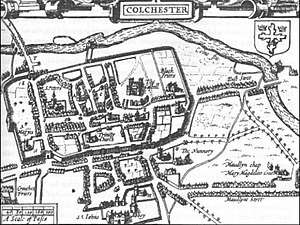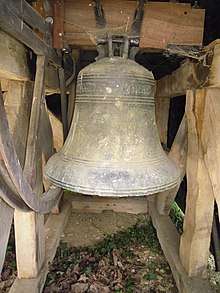Miles Graye
Miles Graye was a dynasty of English bell-founders who had foundries in Colchester and Saffron Walden in Essex during the 17th-century. It is believed that the family cast over 415 bells, many of which remain today.[1]

There were three generations of bell founders of that name who cast in their two foundries but who were also journeymen craftsmen who travelled East Anglia making bells in the fields and churchyards and who practised their craft from the reign of Queen Elizabeth I to James II. A Miles Graye is recorded as being a householder in Colchester in 1567, and it was his son who became the famous bell-founder, Miles Graye I.[2]
Miles Graye I (c1575-1649)
Miles Graye I has been described as 'the prince of bell-founders' and began his career as an apprentice at a foundry in Colchester which belonged to a Richard Bowler. The exact date of his birth is not known, but it was probably in about 1575.[1] His first recorded bell was cast for St Andrew's church in Bulmer in Essex in 1600.[3] The first reference to him as a bell-founder in The Church Bells of Essex is 'by no means creditable to him'. In 1598 Miles was examined by the bailiffs at the Colchester Quarter Sessions and made a voluntary confession accepting that "he is the father of the child with which Alice Mullynges is pregnant", he presumably having met the young woman at the house of Richard Bowler, and who may well have been a domestic servant there.[1] However, Miles did the decent thing and shortly after he married her. His will states that Miles Graye I had four children living at the time of his death: Miles II, James, Ann and Mary. His wife Alice must have died some time previously as he leaves most of his property to 'Dorothy my loving wife'. His will was first written in 1643 and in it he described himself as 'being weak in body and crazed with age, but yet in perfect mind and memory'. His foundry was at Head Street in Colchester. He died in 1649 and it is possible that he endured some financial difficulty in his last year arising from the Siege of Colchester of 1648 during the Civil War when his will of 1649 records that some of his property including his bell-foundry in Head Street[1] was destroyed by fire.[2]
Miles Graye II (c1599-1666)
Miles Graye II married Jane Banishe of Stratford in 1622,[4] and the Saffron Walden parish registers record the baptismal entries of several children of "Miles Gray and of Jane his wife", namely Jacob, 26 November 1630; Jane, 17 January 1632 ; Jane, 19 June 1633 ; Marie, 5 August 1638 ; and Robert, 19 February 1639. The burials of two daughters are also recorded — Jane, 19 February 1631, and Mary, 12 August 1643.[4]
Miles Graye II and his family lived at Saffron Walden for much of the period between 1630 and 1643 when his father Miles Graye I was employing him between the years 1629-1642 as his agent in the counties of Hertfordshire, Bedfordshire and Cambridgeshire.[2][4] It is recorded that Miles Graye II had a foundry in Saffron Walden[1] as there are records of bells being carried there by cart from St Katherine's church in Ickleford in Hertfordshire in 1637:
First payd to Gray of Saffron Walden, bellfounder, for running and casting fower of the Bells belonging to the Church of Ickleford aforesayd, 1 3 l i .
Item payd to James Jackson for carriage of some of the sayd bells by cart to Saffron Walden and for recarriage of them, 20s. Item for carriage of the other of the sayd bells theither and for recarriage of them by this accomptant's owne carte and horses, 20s.
Item to — Gray for mending a bell clapper, 3s.
The foundry was obviously not far from the church as the cost of carrying bells to and from Saffron Walden Church is very low. No bells are recorded as having been cast by Miles Graye II after 1642 and he appears to have left the business at that time, possibly due to the Civil War, although some have argued that he may have had a disagreement with Miles Graye I, possibly over his father's new wife, as he and his sisters received only a shilling each in their father's will.[1] It is believed that Miles II died in 1666.[2]
Miles Graye III (1628-1686)
The third bell-founding Miles Graye, the son of Miles II and Jane, was born at Colchester in 1628 and it was he who carried on the bell-founding business after the death of his grandfather Miles Graye I in 1649. He worked mainly in Cambridgeshire, Bedfordshire, Hertfordshire and Huntingdonshire and continued to cast bells until his death in 1686.[2]
Miles II and Jane also had a son Christopher Graye, born in 1626 and who also became a bell-founder, but he did not work in Colchester or cast any Essex bells. Ann, daughter of Miles Graye I also married a bell-founder, John Darbie, who is known to have cast 161 bells in Suffolk.[2]
Bells cast by Miles Graye

- St Andrew's church, Bulmer, Essex 1600[3]
- St Mary le Tower, Ipswich, 1607 and 1610[7]
- St Mary's church, Ashwell, Hertfordshire 1610
- St Mary's church, Harkstead, Suffolk 1611
- All Saints' church, Wickhambrook, Suffolk 1611 and 1641
- St Margaret's church, Woodham Mortimer, Essex 1612 and 1657
- St. Mary with St. Leonard, Broomfield, Essex 1613
- St Mary's church, Peldon, Essex 1613
- St Mary's church, Kelvedon, Essex 1615[8]
- All-Hallows-the-Great, City of London 1616
- St Mary's church, Stonham Parva, Suffolk 1617
- St Andrew's church, Melton, Suffolk 1618
- St Mary's church, Combs, Suffolk 1619
- St Mary's church, Saffron Walden, Essex 1620
- Holy Trinity church, Bradwell Juxta Coggeshall, Essex 1609, 1621 and 1632
- St Mary Magdalene, Wethersfield, Essex 1623
- St Peter and St Paul's church, Lavenham, Suffolk 1625
- St Andrews church, Belchamp St Paul, Essex 1626, 1682 and 1683
- All Saints church, Theydon Garnon, Essex 1628
- St Margaret's church, Ipswich, 1630 and 1655[9]
- St Mary’s church, Great Leighs, Essex 1634
- Holy Trinity church, Weston, Hertfordshire 1634
- Chiddingly church, Chiddingly, Sussex 1634
- St Nicholas' church, Canewdon, Essex 1634
- All Saints church, Purleigh, Essex 1636
- Queens' College, Cambridge 1637
- St Peter's church, Monks Eleigh, Suffolk 1637 and 1638
- St Andrew's church, Althorne, Essex 1638
- St Mary's church, Henlow, Bedfordshire 1638 and 1650
- St Peter's church, Sudbury, Suffolk 1641
- St Mary the Virgin, Gislingham, Suffolk 1641
- St Katharine's church, Ickleford, Hertfordshire 1650
- St Mary's church, Baldock, Hertfordshire 1650
- St Mary's church, Stotfold, Bedfordshire 1651
- St Nicholas's church, Hinxworth, Hertfordshire 1651
- St Leonard's church, Old Warden, Bedfordshire 1653
- Church of St Peter & St. Paul, Flitwick, Bedfordshire 1653 and 1654
- St Mary's church, Gamlingay, Cambridgeshire 1653
- All Saints' church, Little Staughton, Bedfordshire 1654
- St Laurence's church, Foxton, Cambridgeshire 1654
- St Peter's church, Goldhanger, Essex 1657
- Saints Mary & Michael, Trumpington, Cambridge 1660
- St Peter and St Paul's church, St Osyth, Essex 1663
- St John the Baptist, Layer de la Haye, Essex 1673
- St Peter ad Vincula, Coggeshall, Essex 1681
References
- Karen Bowman, Essex Boys, Amberley Publishing (2013) - Google Books
- Joy Pugh, 'Miles Graye Made Me…', Saffron Walden Historical Journal, No 6 Autumn 2003
- Freda Nicholls, 'Four Colchester Bell Founders' - Colchester Archaeological Group, Annual Bulletin Vol. 41 2000-2001, pgs. 41-42
- Miles Graye of Colchester - Colchester Archaeological Trust
- The Home Counties' Magazine (vol. iv. (1902), pp. 98-100
- G. Montagu Benton, Miles Graye of Colchester (1925) Archaeological Notes - The Colchester Archaeological Trust, pp. 69-71
- The Bells of St Mary-le-Tower - St Mary-le-Tower website
- History of the Church Bells - Kelvedon and Feering Churches website
- Bells of St Margaret's Church, Ipswich - Nicholson Engineering